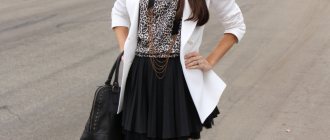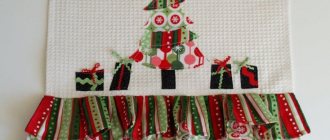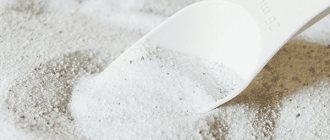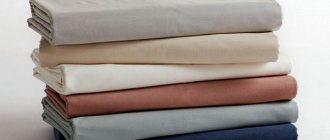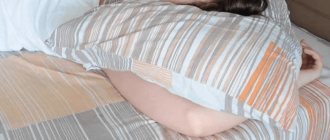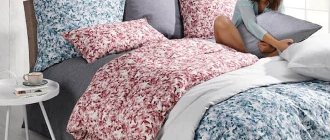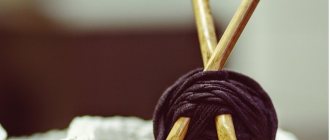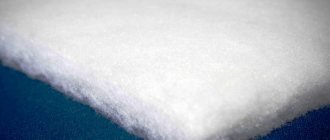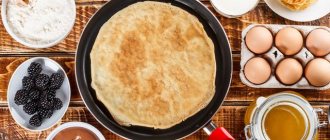The circle skirt almost never goes out of trend; only the priorities in length and fashionable materials change. Among the current trends of the next season in women's fashion, one of the decisive roles is played by flared models of skirts such as sun, bell and multi-layered styles. Such models are suitable for both curvy and thin girls. With the help of correctly selected length and textiles, this element of clothing helps to focus attention on the advantages and hide the flaws of the figure. The return of retro style to the catwalks manifested itself in high waists, wide skirts and trousers, and A-line silhouettes. In this regard, the question of how to sew a circle skirt worries many representatives of the fair sex, regardless of build and age.
What determines the choice of fabric for a skirt?
Choosing fabric is the most important step in preparing for sewing. In order not to miss, you need to understand what criteria influence this:
- the style of the skirt (this is the most important, because a product made from the wrong material will not hold the desired shape);
- time of year (for summer it is more appropriate to take lighter fabrics, and for winter, respectively, dense ones);
- purpose (for the office with heels, for a walk with sneakers, etc.).
A variety of different materials
Now a little more detail about each point.
When choosing a skirt style, it is important to take into account not only personal preferences, but also the specific features of your figure:
- the pencil skillfully emphasizes slender legs and subtle curves of the hips, looks bad on very narrow or, on the contrary, wide hips;
Pencil style
- The tulip is perfect for a figure with large breasts or broad shoulders and a narrow waist, because... visually it noticeably enlarges the hips, but at the same time it is not very suitable for tall girls because it shortens the legs;
- a wrap skirt, due to its interesting style, helps to hide imperfections in the form of a belly or extra folds, while the skirt should be as simple as possible, because you can get the opposite effect;
- The A-silhouette is almost universal, it enhances narrow hips, but at the same time hides wide ones, the only thing that needs to be taken into account is that it visually shortens the legs;
- a circle skirt emphasizes the waist as favorably as possible, but makes the hips massive;
- a year skirt can make wide hips easier, but is contraindicated for women with wide calves;
Godet style
- pleated lengthens and lightens the silhouette, but at the same time looks awkward on large sizes;
- a miniskirt is perfect for those who want their legs to look longer, but you should not overdo it if your initial characteristics are a curvy figure;
- with a peplum will help hide all the disadvantages of the hips, but when sewing it is important to take into account that on a curvaceous figure the peplum should be either higher or lower than the widest part of the hip;
- a straight skirt is suitable for everyone, it elongates the figure well, but you need to take into account that styles to the knee and below visually reduce your height;
You may be interested in Viscose or cotton: which is better, what is the difference
Straight style
- a multi-layer skirt is suitable only for small, thin girls, in other cases it looks very unfortunate;
- a full-length skirt can hide all the imperfections of the legs, but at the same time reduces height.
At the peak of popularity now are straight skirts, pencil, a-line, wraparound, flared, with a front slit, pleated and asymmetrical.
Important! It is the fabric that can emphasize a good cut and impeccable fit. Ineptly selected material can quickly ruin everything.
Based on the time of year as a whole, all the nuances are obvious - for the summer, light flowing fabrics (ideally chiffon or natural cotton), the body should breathe and feel comfortable. In winter, it is best to choose natural wool, boucle or tweed; firstly, such a skirt will keep its shape well, and secondly, it will keep warm well.
Cotton version
If the skirt is supposed to be worn exclusively to the office, then it should not wrinkle in order to always look perfect. Accordingly, this effect can be achieved by adding synthetic fibers.
Characteristics and advantages of skirt materials
Textiles used for sewing skirts must:
- Be resistant to fading and abrasion.
- Have characteristics such as wear resistance and breathability.
However, not all types of matter fully possess these characteristics. All positive properties and characteristics depend on the selected type of textile. If you want to get a durable and high-quality product as a result, experts recommend purchasing natural textiles. For example, for summer models, choose cotton or linen textiles, as they are stretch-resistant and breathable.
Important! Long, floor-length skirts made from thin transparent fabric are supplemented with lining (often above the knee). Such models are not very comfortable to wear in the summer, as they stick to the body and do not allow air to pass through at all, but on the contrary, they create a steam effect.
What fabric are skirts made from?
Absolutely all fabrics are held in high esteem - both natural and with an admixture of synthetics and completely synthetic ones. The most popular fabrics from which skirts are made:
- Natural cotton. This material is almost universal. Thin fabrics are ideal for summer, and thick ones for the cold season. Cotton products breathe well and do not cause discomfort to wear.
- Linen. A material that has long been considered noble. Its ability to allow air to pass through gives the body maximum comfort.
Linen skirt
- Velvet. It is most often used to make holiday clothing because of its specific appearance, but recently stylists have been skillfully incorporating it into everyday looks.
- Jeans. Due to its structure, it successfully emphasizes the figure and hides imperfections. It is because of this that girls with curvaceous figures prefer him. Denim is a universal fabric for both summer and winter.
- Silk. This material is found equally both natural and artificial. Skirts made from it look very festive, and the choice of colors is almost limitless.
Silk option
- Wool (cashmere, tweed, boucle, etc.). Material for cold weather, looks very advantageous. Wool fabric can be of different densities.
- Velveteen. The material, which came into fashion not so long ago, is more suitable for the cold season. It has a specific structure, due to which it looks interesting on any figure.
- Atlas. Smooth fabric that shimmers very effectively. It is very often used on skirts for wedding and evening dresses.
You might be interested in this Comparison of calico, satin, poplin, cotton, polysatin in bed linen
Satin product
As for the color palette, skirts in indigo, emerald, red, burgundy and, of course, classic black will look win-win.
Fabrics for pencil skirts
The name for the product “pencil” has always been considered a basic model in the wardrobe. Absolutely any fabric is perfect for it. Most often, of course, costume ones are used. Such a skirt must keep its shape and not wrinkle, so it is better not to use 100% natural fabric.
The following compositions work well:
- Wool + elastane.
- Wool + lavsan + elastane.
- Wool + viscose + elastane.
For the warm season, linen, knitwear or jeans are good. In cold weather - tweed, drape, corduroy complemented by lining.
Wool + elastane
The fabric for a straight skirt is no different from the choice for a pencil skirt. There can be literally any options, the main thing is to choose wisely for the season. It would be nice if the composition contains stretch.
Footage calculation
The important parameter here is the size of the product. The skirt will be one-piece if it is intended for a child, and the length is assumed to be knee-length. This limitation is due to the width of the fabric. You can sew the product from two parts; for assembly you will need to lay the side seams.
Before purchasing a cut, you must accurately calculate the consumption, otherwise you will not be able to cut out the skirt. To find out how much fabric you will need, we recommend making constructions on paper at a scale of 1:10. To do this, you need to measure the width of the fabric, and then build 2 circles from one center with radii R (calculated by dividing the measured waist circumference by 6, minus 0.5 cm) and R1 (equal to the length of the skirt, taking into account the allowance). Make a similar construction nearby, only from the other edge. Then use a scale ruler to measure the bottom of the drawing and determine the required yardage of fabric.
What fabric to make a sun skirt from
In fact, the circle skirt is a full-fledged circular style, the diagram is a circle with a hole in the middle. Due to this, she looks lush. It requires a large amount of fabric. If you choose a dense one, the product will seem heavy. Therefore, for this style it is recommended to take thin, weightless materials. They look nice and easy. If you still need to sew from thick fabric, then it is better to take a shorter length of the product itself, so as not to create unnecessary weight.
Chiffon skirt "sun"
“Sun” made of thin fabric, for example, chiffon, looks very beautiful due to its impressively falling folds and does not hold volume. But in strong winds it does not hold up and can rise too high. Thick fabric, even without movement, looks fluffy, but confidently holds its shape.
For such a product, thin silk or cotton fabric is ideal, which will fall beautifully, or suit fabric, but not very dense, but loose, so that folds form.
Making a pattern and sewing is easy
To avoid mistakes, we recommend that a beginning seamstress lay out the fabric on a table or floor. The construction must be done on the wrong side of the product. When making calculations, you will need a center to draw circles from it, the radius of which was determined in advance. The second half of the product is built in a similar way. If you have a ready-made pattern, for example from a magazine for sewing enthusiasts, check all the dimensions and you can begin further work. Perform the layout on the spread of the canvas and cut out the details.
If you are sewing a skirt for a child, then the fabric can be folded in 2 or 4 layers, pinned together, and then constructed. This is very convenient and fast to do. You need to cut without unrolling the material.
Assembly algorithm:
- Finish the side edges with an overlock stitch.
- Sew the halves of the product together, leaving 18 cm for the zipper.
- Press the side seams.
- Cut out the belt and duplicate the part with adhesive interlining.
- Overcast one long section, fold in half and iron.
- Sew the raw edge of the waistband to the top of the skirt.
- Pin or baste the zipper and machine stitch it.
- Bend the belt and stitch it, perform a finishing stitch.
- Process the bottom of the product.
Now the long-awaited new thing is ready, it’s time to try it on.
As you can see, cutting and sewing a circle skirt is easy; even a novice seamstress can handle the task. And if you still don’t want to bother, go to the studio and replenish your wardrobe with fashionable things.
What fabric is better to sew a semi-sun skirt from?
The half-sun has all the same features as the sun, except that according to the design it forms a semicircle, accordingly it has less pomp and less fabric is needed to sew it. Half-sun allows you to expand your choice and choose thick fabrics for the fall, because... the product will not be so heavy.
You may be interested in what is special about mercerized cotton
Summer skirt
Fabric for a summer skirt
Summer skirts have more expanse than all others. For the summer, you can take both budget polyester and more expensive cotton, linen, etc. Here it is important to determine how important such fabric properties are, such as wear resistance, shrinkage, and shape.
Of course, any natural fabrics (cotton, linen, silk) are always better, because... the body breathes, does not sweat, does not exhibit allergic reactions, etc. However, they have one significant drawback - they wrinkle and shrink after washing. For summer, from successful and more or less universal options, you can choose cambric or viscose. They are not so prone to wrinkles, but are very comfortable. In extreme heat they can slightly cool the body.
Easy option
In summer fabrics, as in any other case, it is necessary to take into account the style of the product. For straight and pencil skirts, linen, denim, cotton or silk are suitable. For the recently fashionable pleated skirts, it is better to take flowing fabrics - chiffon or silk. For most models, wet silk, cotton and viscose are suitable.
For summer, light translucent fabrics are often used, but products made from them are usually multi-layered (for example, this form of skirt may be called a “tutu”). Sometimes they even take lace or knitted fabric and add a lining underneath.
Almost any skirt fabric is suitable for sewing summer items. The most important thing is to consider what the end result should look like.
How to choose fabric
From the article it is clear that the choice of fabrics for sewing skirts is insanely large. However, for beginners it is better to sew from silk, denim, gabardine - these materials are not picky and fit very well. Velvet, chiffon, and satin may seem difficult. In addition, you should not take fabrics from
Fabric with complex prints
The types of fabrics for skirts are delightful in their abundance, they are limitless - they can be absolutely any and with any composition. The main thing to consider when selecting is that the resulting product should effectively emphasize advantages, hide flaws and correspond to the season of wear. Knowing what fabric you can use to make the skirt you need, you can significantly reduce your search time. Not every sewing school gives such a detailed description.
How to care for “sun” and “half-sun” skirts?
- It is recommended to iron all skirt items from the wrong side. Lush models and those with folds are best ironed with a special steamer in a vertical position.
- Such products should only be stored on hangers, but not on cabinet shelves.
- When it comes to washing skirts, it is best to wash them by hand. This is especially true for materials such as jacquard, wool and silk.
- Products made from synthetic textiles can be washed in a washing machine using the “gentle” setting.
